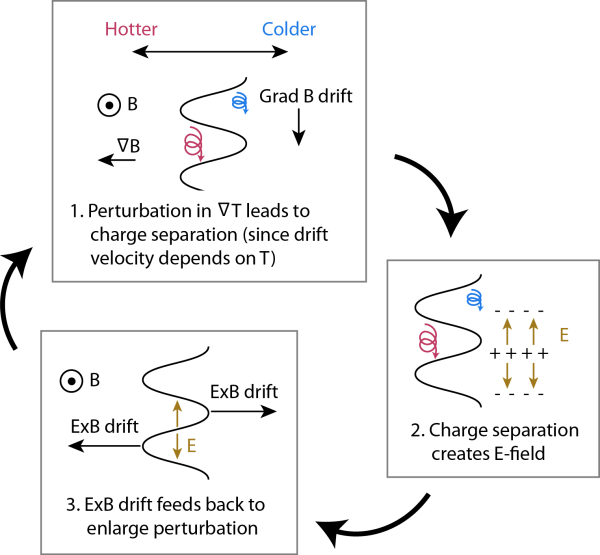Ion Temperature Gradient instability: Difference between revisions
Added a reference (more needed) |
mNo edit summary |
||
| Line 3: | Line 3: | ||
The instability occurs due to the nature of Grad-B drift. The Grad-B drift velocity of a particle (caused by a gradient in the magnetic field) is proportional to the particle's kinetic energy. Hotter particles drift further than colder particles. | The instability occurs due to the nature of Grad-B drift. The Grad-B drift velocity of a particle (caused by a gradient in the magnetic field) is proportional to the particle's kinetic energy. Hotter particles drift further than colder particles. | ||
Hence, if a temperature gradient is aligned with a magnetic field gradient (as occurs in a tokamak), particles in the hotter region will drift further. If there is a perturbation in the temperature gradient, then the difference in drift velocities will create charge separation. The charge separation creates | Hence, if a temperature gradient is aligned with a magnetic field gradient (as occurs in a tokamak), particles in the hotter region will drift further. If there is a perturbation in the temperature gradient, then the difference in drift velocities will create charge separation. The charge separation creates an electric field. This electric field creates an <math>E\times B</math> drift which increases the perturbation's amplitude. The positive-feedback nature of this loop leads to exponential growth of the instability. | ||
Note that if the temperature gradient is anti-parallel to the magnetic field gradient, the <math>E\times B</math> drift will suppress the perturbation rather than increase it. This situation occurs on the inner, "good-curvature" side of the tokamak. | Note that if the temperature gradient is anti-parallel to the magnetic field gradient, the <math>E\times B</math> drift will suppress the perturbation rather than increase it. This situation occurs on the inner, "good-curvature" side of the tokamak. | ||
Latest revision as of 18:21, 28 June 2021
The ion temperature gradient (ITG) instability[1] is a microinstability in tokamaks relevant to turbulence and the associated anomalous transport.
The instability occurs due to the nature of Grad-B drift. The Grad-B drift velocity of a particle (caused by a gradient in the magnetic field) is proportional to the particle's kinetic energy. Hotter particles drift further than colder particles.
Hence, if a temperature gradient is aligned with a magnetic field gradient (as occurs in a tokamak), particles in the hotter region will drift further. If there is a perturbation in the temperature gradient, then the difference in drift velocities will create charge separation. The charge separation creates an electric field. This electric field creates an drift which increases the perturbation's amplitude. The positive-feedback nature of this loop leads to exponential growth of the instability.
Note that if the temperature gradient is anti-parallel to the magnetic field gradient, the drift will suppress the perturbation rather than increase it. This situation occurs on the inner, "good-curvature" side of the tokamak.
See the figure for a graphical explanation.

See also
References
- ↑ P. N. Guzdar, Liu Chen, W. M. Tang and P. H. Rutherford, Ion‐temperature‐gradient instability in toroidal plasmas Phys. Fluids 26 (1983) 673